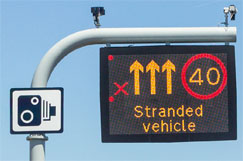Red X signs on smart motorways have been ignored more than 53,000 times since camera enforcement began in 2021, according to new research published by a road safety charity.
Red X signs are used to close lanes on smart motorways when obstructions such as stationary vehicles are detected, with enforcement cameras automatically detecting vehicles passing illegally under a Red X, often resulting in a £100 fine and three points on a driver’s licence.
Although the law was changed in 2019 to allow prosecutions from camera evidence, this type of enforcement did not begin until 2021 and some police forces still do not carry it out.
Based on Freedom of Information (FOI) requests to police forces in England, IAM RoadSmart said that in 2021, nine police forces were enforcing against Red X infringements, with 4,393 offences noted.
 A further 11 forces began prosecuting against the contravention in 2022 resulting in 20,773 infringements being detected. In 2023, there were 28,231 offences logged by 21 forces.
A further 11 forces began prosecuting against the contravention in 2022 resulting in 20,773 infringements being detected. In 2023, there were 28,231 offences logged by 21 forces.
This brings the total to 53,397 since 2021.
IAM Roadsmart said that almost all police forces with smart motorways in their areas are now carrying out this type of enforcement although Sussex police, which has a smart motorway section of the M23 in its area, is not.
Bedfordshire Police did not begin enforcement until 2023 and only caught 28 drivers ignoring the Red X sign during the year, while Northamptonshire Police, which also has a stretch of the M1 in its area, refused to respond.
IAM RoadSmart’s director of policy and standards, Nicholas Lyes, said: ‘Ignoring a Red X sign on a smart motorway is dangerous because it risks a serious collision and for this reason, we welcome police forces clamping down on those who break the law.
‘If a lane is closed on smart motorway, it usually indicates there is either a stranded vehicle ahead, people are working in the road, or there has been a collision. Disobeying the sign puts the lives of those in the vehicle as well as those ahead in danger.’
National Highways said it has delivered nine Red X awareness campaigns since 2016 and that ‘above 90% of drivers’ observe Red X signals.
A spokesperson said: ‘A Red X signal is there to increase the safety of everyone using the road by highlighting an issue ahead.’
Smart motorways, which often have no hard shoulder, use a number of systems to detect stopped vehicles in live lanes, including radar-based stopped vehicle detection (SVD) technology.
As Highways has reported, SVD systems on a quarter of all lane running sections of smart motorway failed to hit National Highways’ benchmark of detecting 80% of stopped vehicles when tested last year.
Commenting on the Red X violation data, RAC road safety spokesperson Rod Dennis said: ‘These figures sadly underline the fragility of one of the systems designed to keep stricken drivers safe on smart motorways.
‘The safety of any driver who is unlucky enough to stop on a smart motorway depends entirely on other people seeing the red-X sign and moving to another lane. It’s therefore terrifying to think that so many people have either ignored them or failed to spot them in the first place.
‘The latter is all the more likely given the fact that on all-lane-running stretches of motorway, where the hard shoulder has been removed completely, it’s largely roadside signs that communicate which lanes are closed which are harder for drivers to read than gantries that span the carriageway and have signs over each lane.’




